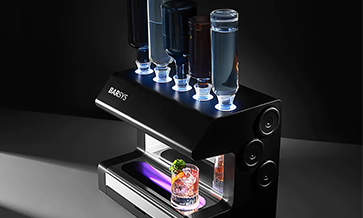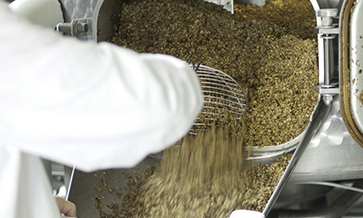Brewery residuals are by no means “waste” – they can be used for energy and fermented to create bio-gas, which is then converted into thermal and electrical energy in a combined heat and power plant.
Breweries are, therefore, capable of providing their own energy supply in a self-sufficient and CO2-neutral manner if they choose to produce on the principle of the Steinecker Brewnomic.
Brewnomic is energetically self-sufficient – as this brewery supplies its own energy by utilising the residual materials accumulated during the brewing process. Brewnomic is also CO2-neutral, as the residual materials are based on renewable raw materials.
Brewnomic thus combines proven brewing technology with a media supply that is gentle on resources – and this in modular building blocks which can also be integrated in your brewery.
The solely energy-based utilisation of biological residual materials is no longer undisputed – they are also nutrient-rich and therefore high in value, for the food industry for example.
Phoenix BMC
In mid-2022, Steinecker GmbH, a brand synonymous with brewing technology, presented its Phoenix BMC development project for the first time – a concept for upcycling brewing residuals and using them for energy recovery.
The pilot installation is running at Brauerei Ustersbacher in Bavaria (Germany), where the first module is now fully up and running. It has been in operation since 1605, and boasts of a portfolio of a dozen beers, its own mineral water brand and some non-alcoholic beverages.
With Phoenix BMC, Steinecker is able to convert brewing residuals into valuable raw materials. The extracted proteins and mineral fertiliser can be sold, and the process water can be recycled on-site. The bio-gas so generated can fuel a combined heat and power (CHP) plant for energy recovery directly at the brewery.
In this first module, spent grains, malt dust and yeast are processed to extract a liquid protein solution known as protein hydrolysate. For this, the mash runs through a colloid mill and a membrane filter.
Based on an annual output of 750,000 hecto-litre, the return on investment for this system is quite impressive. The first module of Phoenix BMC has paid for itself in just 3 years!
That is in large part attributable to the excellent quality of the hydrolysate – 55% of the amino acids obtained are essential amino acids. The excellent quality of the extracted protein means that it can be used in several areas within the food industry.
Protein inhibitor
With conventional bio-gas plants, there are limits to the degree to which the solid brewery residuals, such as spent grains, malt dust and yeast, can be processed. In addition to the already poor usability of the residual materials, they also contain substances that have an inhibiting effect on the activity of the various micro-organisms in a bio-gas plant.
Once these inhibitors are first removed from the brewery residuals, considerably less time is needed to use the residual materials with organisms effectively. The bio-gas plant can be built considerably smaller and also cheaper.
In the bio-gas plant, the existing proteins are broken down by one of the many strains of bacteria, and the amino groups of the amino acids released as ammonium.
Depending on the pH value, the ammonium is in a chemical equilibrium with the ammoniac, which inhibits the activity of a further strain of bacteria. This breaks down fatty acids which, if the concentration is too high, deactivate the methane-creating bacteria in the bio-gas plant.
The breaking down of the proteins in the bio-gas system starts inhibiting methane production. The protein and already released ammonium must, therefore, be separated from the residual materials before bio-gas fermentation can begin.
Many benefits
Plant-based protein is, however, also a very sought-after raw material, which is primarily used in the manufacture of meat and milk-substitute products. Ammonium, which is obtained in the form of mineral fertiliser and urgently required in the farming industry, can be lucratively sold by the brewery.
Protein hydrolyzate and mineral fertiliser can be acquired from the brewery residuals. Selling them on provides a major contribution to the amortisation of the plant for biomass conversion. Both this and the better recyclability of the residual materials in the biogas system make an investment in your own self-sufficient energy supply lucrative.
The increasing percentage of bio-gas reduces the need for fossil fuels. Using the corresponding modules from the Brewnomic concept will make it possible to cover a brewery’s entire energy requirement. Since the residual materials are of a biological origin, the brewery is also CO2-neutral.
Courtesy: Krones & Steinecker














